Resonance Raman detection of carotenoid antioxidants in living human tissue
- PMID: 16409093
- PMCID: PMC3086339
- DOI: 10.1117/1.2139974
Resonance Raman detection of carotenoid antioxidants in living human tissue
Abstract
Increasing evidence points to the beneficial effects of carotenoid antioxidants in the human body. Several studies, for example, support the protective role of lutein and zeaxanthin in the prevention of age-related eye diseases. If present in high concentrations in the macular region of the retina, lutein and zeaxanthin provide pigmentation in this most light sensitive retinal spot, and as a result of light filtering and/or antioxidant action, delay the onset of macular degeneration with increasing age. Other carotenoids, such as lycopene and beta-carotene, play an important role as well in the protection of skin from UV and short-wavelength visible radiation. Lutein and lycopene may also have protective function for cardiovascular health, and lycopene may play a role in the prevention of prostate cancer. Motivated by the growing importance of carotenoids in health and disease, and recognizing the lack of any accepted noninvasive technology for the detection of carotenoids in living human tissue, we explore resonance Raman spectroscopy as a novel approach for noninvasive, laser optical carotenoid detection. We review the main results achieved recently with the Raman detection approach. Initially we applied the method to the detection of macular carotenoid pigments, and more recently to the detection of carotenoids in human skin and mucosal tissues. Using skin carotenoid Raman instruments, we measure the carotenoid response from the stratum corneum layer of the palm of the hand for a population of 1375 subjects and develop a portable skin Raman scanner for field studies. These experiments reveal that carotenoids are a good indicator of antioxidant status. They show that people with high oxidative stress, like smokers, and subjects with high sunlight exposure, in general, have reduced skin carotenoid levels, independent of their dietary carotenoid consumption. We find the Raman technique to be precise, specific, sensitive, and well suitable for clinical as well as field studies. The noninvasive laser technique may become a useful method for the correlation between tissue carotenoid levels and risk for malignancies or other degenerative diseases associated with oxidative stress.
Figures
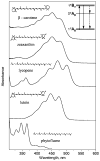
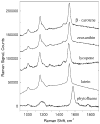
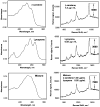


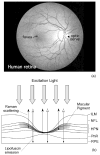
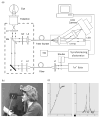


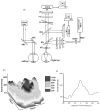

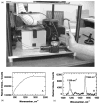
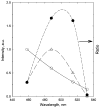

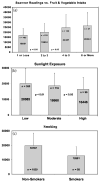
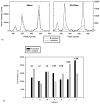


Similar articles
-
Resonance Raman measurement of macular carotenoids in normal subjects and in age-related macular degeneration patients.Ophthalmology. 2002 Oct;109(10):1780-7. doi: 10.1016/s0161-6420(02)01173-9. Ophthalmology. 2002. PMID: 12359594 Free PMC article.
-
Resonance Raman measurement of macular carotenoids in the living human eye.Arch Biochem Biophys. 2004 Oct 15;430(2):163-9. doi: 10.1016/j.abb.2004.07.004. Arch Biochem Biophys. 2004. PMID: 15369814 Review.
-
Noninvasive selective detection of lycopene and beta-carotene in human skin using Raman spectroscopy.J Biomed Opt. 2004 Mar-Apr;9(2):332-8. doi: 10.1117/1.1646172. J Biomed Opt. 2004. PMID: 15065899
-
Validation model for Raman based skin carotenoid detection.Arch Biochem Biophys. 2010 Dec 1;504(1):40-9. doi: 10.1016/j.abb.2010.07.023. Epub 2010 Aug 1. Arch Biochem Biophys. 2010. PMID: 20678465
-
Noninvasive detection of macular pigments in the human eye.J Biomed Opt. 2004 Jan-Feb;9(1):75-85. doi: 10.1117/1.1628240. J Biomed Opt. 2004. PMID: 14715058 Review.
Cited by
-
Weight Status and Visceral Adiposity Mediate the Relation between Exclusive Breastfeeding Duration and Skin Carotenoids in Later Childhood.Curr Dev Nutr. 2021 Feb 15;5(3):nzab010. doi: 10.1093/cdn/nzab010. eCollection 2021 Mar. Curr Dev Nutr. 2021. PMID: 33758790 Free PMC article.
-
Association between atherosclerotic cardiovascular disease score and skin carotenoid levels estimated via refraction spectroscopy in the Japanese population: a cross-sectional study.Sci Rep. 2024 May 28;14(1):12173. doi: 10.1038/s41598-024-62772-y. Sci Rep. 2024. PMID: 38806551 Free PMC article.
-
Resonance Raman spectroscopic evaluation of skin carotenoids as a biomarker of carotenoid status for human studies.Arch Biochem Biophys. 2013 Nov 15;539(2):163-70. doi: 10.1016/j.abb.2013.06.007. Epub 2013 Jun 30. Arch Biochem Biophys. 2013. PMID: 23823930 Free PMC article. Review.
-
Zeaxanthin has enhanced antioxidant capacity with respect to all other xanthophylls in Arabidopsis leaves and functions independent of binding to PSII antennae.Plant Physiol. 2007 Dec;145(4):1506-20. doi: 10.1104/pp.107.108480. Epub 2007 Oct 11. Plant Physiol. 2007. PMID: 17932304 Free PMC article.
-
Accessing Properties of Molecular Compounds Involved in Cellular Metabolic Processes with Electron Paramagnetic Resonance, Raman Spectroscopy, and Differential Scanning Calorimetry.Molecules. 2023 Sep 3;28(17):6417. doi: 10.3390/molecules28176417. Molecules. 2023. PMID: 37687246 Free PMC article. Review.
References
-
- Koyama Y. Resonance Raman spectroscopy. In: Britton G, Liaaen-Jensen, Pfander H, editors. Carotenoids, Vol. 1B, Spectroscopy. Birkhäuser; Basel: 1995. pp. 135–146.
-
- Bernstein PS, Yoshida MD, Katz NB, McClane RW, Gellermann W. Raman detection of macular carotenoid pigments in intact human retina. Invest Ophthalmol Visual Sci. 1998;39:2003–2011. - PubMed
-
- Gellermann W, Ermakov IV, Ermakova MR, McClane RW, Zhao DY, Bernstein PS. In vivo resonant Raman measurement of macular carotenoid pigments in the young and the aging human retina. J Opt Soc Am A. 2002;19:1172–1186. - PubMed
-
- Zhao D-Y, Wintch SW, Ermakov IV, Gellermann W, Bernstein PS. Resonance Raman measurement of macular carotenoids in retinal, choroidal, and macular dystrophies. Arch Ophthalmol (Chicago) 2003;121:967–972. - PubMed
Publication types
MeSH terms
Substances
Grants and funding
LinkOut - more resources
Full Text Sources
Other Literature Sources
Medical

